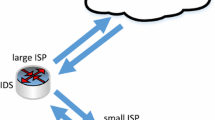Abstract
Internet attacks such as distributed denial-of-service (DDoS) attacks and worm attacks are increasing in severity. Identifying realtime attack detection and mitigation of Internet traffic is an important and challenging problem. For example, a compromised host doing fast scanning for worm propagation often makes an unusually high number of connections to distinct destinations within a short time. We call such a host a superpoint, which are sources that connect to a large number of distinct destinations. Detecting superpoints is very important in developing effective and efficient traffic engineering schemes. We propose two novel schemes for detecting superpoints and prove guarantees on their accuracy and memory requirements. These schemes are implemented by introducing a reversible counting Bloom filter (RCBF), a special counting Bloom filter. The RCBF consists of 4 hash functions which projectively select some consecutive bits from original strings as function values. We obtain the information of superpoints using the overlapping of hash bit strings of the RCBF. The theoretical analysis and experiment results show that our schemes can precisely and efficiently detect superpoints.
Similar content being viewed by others
References
El-Atawy A, Al-Shaer E, Tran T, Boutaba R (2009) Adaptive early packet filtering for protecting firewalls against DoS attacks. In: IEEE INFOCOM 2009, April, pp 2437–2445
Moore D, Paxson V, Savage S, Shannon C, Staniford S, Weaver N (2003) Inside the slammer worm. Secur Privacy Mag 2(4):33–39
Goodrich MT (2008) Probabilistic packet marking for large-scale IP traceback. IEEE/ACM Trans Netw 16(1):15–24
Xiang Y, Zhou W, Guo M (2009) Flexible deterministic packet marking: an IP traceback system to find the real source of attacks. IEEE Trans Parallel Distrib Syst 20(4):567–580. doi:10.1109/TPDS.2008.132
Roesch M (1999) Snort-lightweight intrusion detection for network. In: Proc USENIX systems administration conference, pp 228–238
Plonka D (2000) Flowscan: a network traffic flow reporting and visualization tool. In: USENIX LISA, pp 305–318
Venkataraman S, Song D, Gibbons P, Blum A (2005) New streaming algorithms for fast detection of superspreaders. In: Proc NDSS, pp 149–166
Zhao Q, Kumar A, Jun X (2005) Joint data streaming and sampling techniques for detection of super sources and destinations. In: IMC 2005, pp 77–90
Kamiyama N, Mori T, Kawahara R (2007) Simple and adaptive identification of superspreaders by flow sampling. In: INFOCOM 2007, pp 2481–2485
Cheng G, Gong J, Ding W, Wu H, Qiang SQ (2008) Detecting superpoint algorithm based on adaptive samling. Sci China, E-Inf Sci 38(10):1679–1696
Guan X, Pinghui W, Qin T (2009) A new data streaming method for locating hosts with large connection degree. In: IEEE Globecom 2009, November, pp 1–6
Cao J, Jin Y, Chen A, Bu T, Zhang Z-L (2009) Identifying high cardinality internet hosts. In: IEEE INFOCOM 2009, April, pp 810–818
Claffy KC, Braun HW, Polyzos GC (1995) A parameterizable methodology for Internet traffic flow profiling. IEEE J Sel Areas Commun 13:1481–1494
Jain R, Routhier SA (1986) Packet trains-measurements and a new model for computer network traffic. IEEE J Sel Areas Commun 4:986–995
Kumar A, Sung M, Xu J, Wang J (2004) Data streaming algorithms for efficient and accurate estimation of flow size distribution. In: Proc ACM SIGMETRICS, pp 177–188
Cypress Semiconductor Corporation (2010). http://www.cypress.com/
Cohen S, Matias Y (2003) Spectral Bloom filters. In: Proceedings of the ACM SIGMOD 2003, San Diego, CA, USA, pp 241–252
WIDE (2010) http://tracer.csl.sony.co.jp/mawi/samplepoint-F/20090330/200903300000.html
Ramakrishna MV (1989) Practical performance of Bloom filters and parallel free-text searching. Commun ACM 32(10):1237–1239
JSLAB (2010) http://ntds.njnet.edu.cn/data/index.php
NLANR (2010) ftp://wits.cs.waikato.ac.nz/pma/long/ipls/3/
Author information
Authors and Affiliations
Corresponding author
Rights and permissions
About this article
Cite this article
Liu, W., Qu, W., He, X. et al. Detecting superpoints through a reversible counting Bloom filter. J Supercomput 63, 218–234 (2013). https://doi.org/10.1007/s11227-010-0511-2
Published:
Issue Date:
DOI: https://doi.org/10.1007/s11227-010-0511-2




